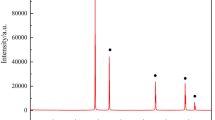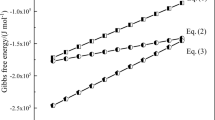Abstract
Based on the desulfurization process of molten iron with magnesium vapor produced in situ by the aluminothermic reduction of magnesium oxide, methods for improving the desulfurization efficiency of magnesium (η S,Mg) have been studied.
By use of the mixed-control model of gas- and liquid-phase mass transfer developed in a previous article, it is shown that η S,Mg can be improved by reducing the bubble size, increasing the lance immersion depth, dividing MgO-Al pellet charging into several portions, and lowering the operating temperature. A new method for improving η S,Mg, by adjusting the initial magnesium molar ratio in the bubble (N Mg,0) through a change in the Ar carrier gas flow rate, is proposed. The optimum initial magnesium molar ratio in the bubble (N Mg,opt) for obtaining the maximum η S,Mg value exists, and its value changes with the sulfur concentration in the molten iron. Under the condition of N Mg,0=N Mg,opt, reducing the bubble diameter improves η S,Mg and decreases the Ar carrier gas flow rate that is needed to adjust N Mg,0 to N Mg,opt. The aluminum consumption is decreased by the use of the 4MgO-2Al pellet instead of the 3MgO-2Al pellet and is further decreased by lowering the temperature from 1673 to 1623 K.
Experimental examinations of the influences of lance immersion depth, pellet charging method, and carrier gas flow-rate pattern have been conducted. Reasonable agreement between the calculated and the experimental results indicates the validity of the present optimization method.
Similar content being viewed by others
Abbreviations
- A :
-
surface area of a bubble (m2)
- A s :
-
surface area of the melt (m2)
- A(t 1):
-
surface area of a bubble at t=t 1 during the bubble formation (m2)
- D l,Mg :
-
diffusion coefficient of magnesium in the melt (m2/s)
- D l,S :
-
diffusion coefficient of sulfur in the melt (m2/s)
- d B :
-
bubble diameter (m)
- f S :
-
activity coefficient of sulfur
- g :
-
gravitational acceleration (m/s2)
- ΔG o :
-
standard Gibbs free energy change (kJ/mol)
- H :
-
Henry’s constant for dissolution of magnesium vapor into the melt (atm−1)
- H L :
-
lance immersion depth (m)
- K MgS :
-
equilibrium constant of Reaction [7](K MgS ≡ a MgS/(P Mg·a S))
- k g,Mg :
-
mass-transfer coefficient of magnesium in the bubble (m/s)
- k l,S :
-
mass-transfer coefficient of sulfur in the melt (m/s)
- k l,Mg :
-
mass-transfer coefficient of magnesium in the melt (m/s)
- k l,Mg,S :
-
mass-transfer coefficient of magnesium to the melt surface (m/s)
- M Mg :
-
molecular mass of magnesium (kg/mol)
- M S :
-
molecular mass of sulfur (kg/mol)
- N Mg,0 :
-
initial molar ratio of magnesium in a bubble
- N Mg,opt :
-
optimum initial molar ratio of magnesium in a bubble
- n Mg,B :
-
number of moles of magnesium in a bubble (mol)
- n Mg,f :
-
number of moles of magnesium dissolved into the melt by one bubble during its formation (mol)
- n Mg,l :
-
number of moles of magnesium in the melt (mol)
- n S :
-
number of moles of sulfur in the melt (mol)
- n S,f :
-
number of moles of sulfur removed by one bubble during its formation (mol)
- P Mg :
-
magnesium partial pressure in the bubble (atm)
- P Mg,0 :
-
initial magnesium partial pressure in the bubble (atm)
- P Mg,e :
-
magnesium partial pressure in equilibrium with sulfur in the melt (atm)
- P Mg,i :
-
magnesium partial pressure on the bubble surface (atm)
- [ppm Mg]:
-
magnesium concentration in the melt
- [ppm Mg] i :
-
magnesium concentration on the bubble surface
- [ppm Mg] S :
-
magnesium concentration on the melt surface
- R :
-
gas constant (atm·m3·mol−1·K−1)
- [ppm S]:
-
sulfur concentration in the melt
- [ppm S] i :
-
sulfur concentration on the bubble surface
- Q Ar :
-
Ar carrier gas flow rate at 298 K and 1 atm (m3/s)
- Q Ar,opt :
-
optimum Ar carrier gas flow rate at 298 K and 1 atm (m3/s)
- T :
-
temperature (K)
- t :
-
time (s)
- t′:
-
time for calculating n S,f (s)
- t 1 :
-
time for calculating n S,f (s)
- t f :
-
bubble formation time (s)
- t pe :
-
time for charging pellet (s)
- V m :
-
volume of the melt (m3)
- v B :
-
ascent velocity of a bubble (m/s)
- W 0,Al :
-
initial mass of Al in the pellet (g)
- W 0,MgO :
-
initial mass of MgO in the pellet (g)
- W Al :
-
mass of aluminum consumption per ton of melt (kg/t)
- W Mg :
-
mass of magnesium produced by reduction of pellet (g)
- W Mg,S :
-
mass of Mg actually reacted with sulfur (g)
- W pe :
-
mass of pellet consumption per ton of the melt (kg/t)
- W R,Al :
-
mass of Al consumed during the experiment (g)
- W R,MgO :
-
mass of MgO reduced during the experiment (g)
- W to :
-
initial total mass of MgO and aluminum in the pellet (g)
- x :
-
vertical distance from nozzle exit (m)
- η R,Al :
-
utilization efficiency of aluminum (pct)
- η R,MgO :
-
reduction efficiency of magnesium oxide (pct)
- η S,Mg :
-
desulfurization efficiency of magnesium (pct)
- η S,P :
-
desulfurization efficiency of the pellet (pct)
- ρ m :
-
melt density (kg/m3)
- σ :
-
surface tension of melt (N/m)
References
M.C. Ashton, R.K. Buhr, J.G. Magny, and K.G. Davis: Ironmaking and Steelmaking, 1975, vol. 2, pp. 111–14.
P.J. Koros, R.G. Petrushka, and R.G. Kerlin: Iron Steelmaker, 1977, vol. 4 (6), pp. 34–40.
G.A. Irons and R.I.L. Guthrie: Metall. Trans. B, 1981, vol. 12B, pp. 755–69.
A. Aoyagi, Z. Mukuda, S. Takada, and S. Oomiya: CAMP-ISIJ, 1994, vol. 7, p. 221.
Y. Hiraga, K. Gennai, and J. Harama: CAMP-ISIJ, 1996, vol. 9, pp. 225.
H. Shima, M. Iguchi, H. Huzihara, H. Nagahama, K. Ounuki, and K. Muranishi: CAMP-ISIJ, 1995, vol. 8, p. 106.
H. Tomida, T. Kunishima, S. Kadou, and Z. Ikeda: CAMP-ISIJ, 1994, vol. 7, p. 222.
K. Kimura, I. Kikuti, S. Kodaira, Y. Komatsu, Z. Hukumi, and T. Toyota: CAMP-ISIJ, 1995, vol. 8, p. 105.
K. Nakanishi, A. Ejima, T. Suzuki, and F. Sudo: Tetsu-to-Hagané, 1978, vol. 64, pp. 1323–32.
M. Mikuni, K. Takahashi, Y. Ueshima, A. Aoyagi, O. Okuda, and R. Nagai: CAMP-ISIJ, 1995, vol. 8, p. 929.
S. Yamaguchi, T. Uemura, H. Nashiwa, and H. Sugita: Ironmaking and Steelmaking, 1977, vol. 5, pp. 276–79.
S. Hosohara, Y. Kato, H. Nakato, and K. Sorimachi: Tetsu-to-Hagané, 2002, vol. 88, pp. 129–35.
T. Fujita, K. Matsuo, and S. Nakashima: CAMP-ISIJ, 1994, vol. 7, p. 218.
J. Hirama, K. Gennai, Y. Hiraga, and Y. Nakajima: CAMP-ISIJ, 1995, vol. 8, p. 104.
G.A. Irons and R.I.L. Guthrie: Ironmaking and Steelmaking, 1981, vol. 8, pp. 114–21.
G.A. Irons and R.I.L. Guthrie: Can. Metall. Q., 1982, vol. 21, pp. 429–43.
J. Yang, S. Ozaki, R. Kakimoto, K. Okumura, M. Kuwabara, and M. Sano: Iron Steel Inst. Jpn. Int., 2001, vol. 41, pp. 945–54.
J. Yang, K. Okumura, M. Kuwabara, and M. Sano: Iron Steel Inst. Jpn. Int., 2001, vol. 41, pp. 965–73.
J. Yang, K. Okumura, M. Kuwabara, and M. Sano: Iron Steel Inst. Jpn. Int., 2002, vol. 42, pp. 595–602.
J. Yang, K. Okumura, M. Kuwabara, and M. Sano: Iron Steel Inst. Jpn. Int., 2002, vol. 42, pp. 685–93.
L. Hong, K. Okumura, and M. Sano: Metall. Trans. B, 1999, vol. 30B, pp. 1003–08.
E.T. Turkdogan: Physical Chemistry of High Temperature Technology, Academic Press Inc., New York, NY, 1980, pp. 5–24.
R. Higbie: Trans. AICHE J., 1935, vol. 31, pp. 365–89.
D.W.V. Krevelen and P.J. Hoftijzer: Chem. Eng. Progr., 1950, vol. 46, pp. 29–35.
The Japan Institute of Metals: Metal Data Book, Maruzen, Tokyo, 1993, p. 55.
D.R. Poirier and G.H. Geiger: Transport Phenomena in Materials Processing, TMS, Warrendale, PA, 1994, pp. 453–56.
T. Tadaki and S. Maeda: Kagaku Kougaku (Chem. Eng., Jpn.), 1963, vol. 27, pp. 147–55.
J. Shan, K. Okumura, M. Kuwabara, and M. Sano: Tetsu-to-Hagané, 2001, vol. 87, pp. 635–42.
Author information
Authors and Affiliations
Rights and permissions
About this article
Cite this article
Yang, J., Okumura, K., Kuwabara, M. et al. Improvement of desulfurization efficiency of molten iron with magnesium vapor produced In situ by aluminothermic reduction of magnesium oxide. Metall Mater Trans B 34, 619–629 (2003). https://doi.org/10.1007/s11663-003-0032-y
Received:
Issue Date:
DOI: https://doi.org/10.1007/s11663-003-0032-y




